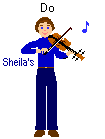SOUND Violin Thoughts   
 Corner Violin BBoard Corner Violin BBoard
used with permission from Professor Reed Smith Marshall University * Department of Music
|
SOUND Violin Thoughts   
 Corner Violin BBoard Corner Violin BBoard
used with permission from Professor Reed Smith Marshall University * Department of Music
|